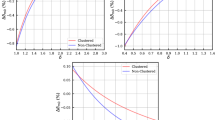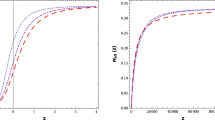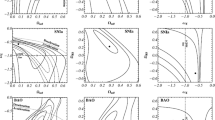Abstract
It is known than the inclusion of spatial curvature can modify the evolution of matter perturbations and affect the Large Scale Structure (LSS) formation. We quantify the effects of the nonzero spatial curvature in terms of LSS formation for a cosmological model with a running vacuum energy density and a warm dark matter component. The evolution of density perturbations and the modified shape of their power spectrum are constructed and analyzed.



Similar content being viewed by others
Notes
Here and from now on we use the notations \(\Omega_{i}(z)=\rho_{i}(z)/\rho^{0}_{c}\), where \(\rho^{0}_{c}=3H_{0}^{2}/(8\pi G)\). It is easy to see that this is the density relative to the critical density at \(a_{0}\), that means nowadays, and not to the time-dependent density.
REFERENCES
N. Aghanim et al., “Planck 2018 results. VI. Cosmological parameters,” arXiv: 1807.06209.
L. Anderson et al., “The clustering of galaxies in the SDSS-III Baryon Oscillation Spectroscopic Survey: baryon acoustic oscillations in the Data Releases 10 and 11 Galaxy samples,” MNRAS 441 (1), 24 (2014).
S. Weinberg, “The cosmological constant problem,” Rev. Mod. Phys. 61, 1 (1989).
S. Weinberg, “Anthropic bound on the cosmological constant,” Phys. Rev. Lett. 59, 2607 (1987).
I. L. Shapiro and J. Solà, “Scaling behavior of the cosmological constant: Interface between quantum field theory and cosmology,” JHEP 02, 006 (2002).
I. L. Shapiro, “Effective action of vacuum: Semiclassical approach,” Class. Quant. Grav. 25,103001 (2008).
V. Sahni and A. A. Starobinsky, “The case for a positive cosmological \(\Lambda\)-term,” Int. Journ. Mod Phys.D 9, 373 (2000).
P. J. E. Peebles and B. Ratra, “The cosmological constant and dark energy,” Rev. Mod. Phys. 75, 559 (2003).
V. Sahni and A. Starobinsky, “Reconstructing Dark Energy,” Int. J. Mod. Phys. D 15, 2105 (2006).
G. Bertone, D. Hooper, and J. Silk, “Particle dark matter: Evidence, candidates and constraints,” Phys. Rep. 405, 279 (2005).
M. Tegmark et al., “The three-dimensional power spectrum of galaxies from the Sloan digital sky survey,” Astroph. J. 606, 702 (2004).
N. Aghanim et al., “Planck 2018 results. V. CMB power spectra and likelihoods,” arXiv: 1907.12875.
S. Capozziello and M. De Laurentis, “Extended theories of gravity,” Phys. Rep. 509, 167 (2011).
I. L. Buchbinder, S. D. Odintsov, and I. L. Shapiro, Effective action in quantum gravity (IOP Publishing, Bristol, 1992).
T. Taylor and G. Veneziano, “Quantum gravity at large distances and the cosmological constant,” Nucl. Phys. B 345, 210 (1990).
B. L. Giacchini, T. de Paula Netto, and I. L. Shapiro, “On the Vilkovisky unique effective action in quantum gravity,” arXiv: 2006.04217.
I. L. Shapiro and J. Solà, “On the possible running of the cosmological ‘constant’,” Phys. Lett. B 682, 105 (2009).
I.L. Shapiro, J. Solà, C. España-Bonet, and P. Ruiz-Lapuente, “Variable cosmological constant as a Planck scale effect,” Phys. Lett. B 574, 149 (2003).
J. C. Fabris, I. L. Shapiro, and J. Solà, “Density perturbations for running cosmological constant,” JCAP 0702, 016 (2007).
I. L. Shapiro, J. Solà, and H. Stefancic, “Running \(G\) and \(\Lambda\) at low energies from physics at M\({}_{X}\): possible cosmological and astrophysical implications,” JCAP 0501, 012 (2005).
J. Grande, J. Solà, J. C. Fabris, and I. L. Shapiro, “Cosmic perturbations with running G and Lambda,” Class. Quantum Grav. 27, 105004 (2010).
J. Solá, “Cosmological constant and vacuum energy: old and new ideas,” J. Phys.: Conf. Series. 453 (IOP Publishing, 2013).
E. L. D. Perico and D. A. Tamayo, “Running vacuum cosmological models: linear scalar perturbations,” JCAP 1708, 026 (2017).
S. Basilakos, N. E. Mavromatos, and J. Solá, “Gravitational and chiral anomalies in the running vacuum universe and matter-antimatter asymmetry,” Phys. Rev. D D01, 045001 (2020).
S. Hannestad and R. J. Scherrer, “Self-interacting warm dark matter,” Phys. Rev. D 62, 043522 (2000).
P. Bode, J. P. Ostriker, and N. Turok, “Halo formation in warm dark matter models,” Astroph. J.556, 93 (2001).
M. Viel, J. Lesgourgues, M. G. Haehnelt, S. Matarrese, and A. Riotto, “Constraining warm dark matter candidates including sterile neutrinos and light gravitinos with WMAP and the Lyman-\(\alpha\) forest,” Phys. Rev. D 71, 063534 (2005).
A. D. Sakharov, “The initial stage of an expanding universe and the appearance of a nonuniform distribution of matter,” Sov. Phys. JETP 22, 241 (1966).
G. de Berredo-Peixoto, I. L. Shapiro, and F. Sobreira, “Simple cosmological model with relativistic gas,” Mod. Phys. Lett. A 20, 2723 (2005).
F. Jüttner, “Die Dynamik eines bewegten Gases in der Relativit’átstheorie,” Ann. der Physik 6, 145 (1911).
J. C. Fabris, I. L. Shapiro, and F. Sobreira, “DM particles: how warm they can be?” JCAP 0902, 001 (2009).
J. C. Fabris, I. L. Shapiro, and A. M. Velasquez-Toribio, “Testing dark matter warmness and quantity via the reduced relativistic gas model,” Phys. Rev. D 85, 023506 (2012).
W. S. Hipólito-Ricaldi, R. F. Marttens, J. C. Fabris, I. L. Shapiro, and L. Casarini, “On general features of warm dark matter with reduced relativistic gas,” Eur. Phys. J. C 78, 365 (2018).
J. A. Agudelo Ruiz, T. de Paula Netto, J. C. Fabris, and I.L. Shapiro, Primordial universe with the running cosmological constant, arXiv:1911. 06315; to appear in Eur. Phys. J. C.
Ya. B. Zeldovich and A. A. Starobinsky, “Particle production and vacuum polarization in an anisotropic gravitational field,” Sov. Phys. JETP 34, 1159 (1972); [Zh. Eksp. Teor. Fiz. 61, 2161 (1971)].
A. Dobado and A. L. Maroto, “Particle production from nonlocal gravitational effective action,” Phys. Rev. D 60, 104045 (1999).
D. M. Scolnic et al., “The complete light-curve sample of spectroscopically confirmed SNe Ia from Pan-STARRS1 and cosmological constraints from the combined pantheon sample,” Astroph. J. 859, 101 (2018).
L. Anderson et al., “The clustering of galaxies in the SDSS-III Baryon Oscillation Spectroscopic Survey: baryon acoustic oscillations in the Data Releases 10 and 11 Galaxy samples,” MNRAS 441, 24 (2014).
J. Ooba, B. Ratra, and N. Sugiyama, “Planck 2015 constraints on the non-flat \(\Lambda\)CDM inflation model,” Astroph. J. 864, 80 (2018).
J. Ooba, B. Ratra, and N. Sugiyama, “Planck 2015 constraints on the non-flat XCDM inflation model,” Astroph. J. 869, 34 (2018).
J. Ooba, B. Ratra, and N. Sugiyama, “Planck 2015 constraints on the nonflat \(\phi\)CDM inflation model,” Astroph. J.866, 68 (2018).
C. Park and B. Ratra, “observational constraints on the tilted spatially flat and the untilted nonflat \(\phi\)CDM dynamical Dark Energy inflation models,” Astroph. J. 868, 83 (2018).
C. Park and B. Ratra, “Observational constraints on the tilted flat-XCDM and the untilted nonflat XCDM dynamical dark energy inflation parameterizations,” Astroph. Space Sci. 364, 82 (2019).
A. M. Velasquez-Toribio and A. dos R. Magnago, “Observational constraints on the non-at \(\Lambda\)CDM model and a null test using the transition redshift,” Eur. Phys. J. C 80, 562 (2020).
J. Ryan, S. Doshi, and B. Ratra, “Constraints on dark energy dynamics and spatial curvature from Hubble parameter and baryon acoustic oscillation data,” MNRAS 480, 759 (2018).
J. Ryan, Y. Chen, and B. Ratra, “Baryon acoustic oscillation, Hubble parameter, and angular size measurement constraints on the Hubble constant, dark energy dynamics, and spatial curvature,” MNRAS 488, 3844 (2019).
C. Park and B. Ratra, “Using SPTpol, Planck 2015, and non-CMB data to constrain tilted spatially-flat and untilted non-flat \(\Lambda\) CDM, XCDM, and \(\phi\) CDM dark energy inflation cosmologies,” Phys. Rev. D 101, 083508 (2020).
W. Handley “Primordial power spectra for curved inflating universes,” Phys. Rev. D 100, 123517 (2019).
S. Castardelli dos Reis and I. L. Shapiro, “Cosmic anisotropy with reduced relativistic gas,” Eur. Phys. J. C 78, 145 (2018).
G. Pordeus-da-Silva, R. Batista, and L. Medeiros, “Theoretical foundations of the reduced relativistic gas in the cosmological perturbed context,” JCAP 06, 043 (2019).
N. R. Bertini, W. S. Hipólito-Ricaldi, F. de Melo-Santos, and D. C. Rodrigues, “Cosmological framework for renormalization group extended gravity at the action level,” Eur. Phys. J. C 80, 479 (2020).
A. A. Starobinsky, “A new type of isotropic cosmological models without singularity,” Phys. Lett. B 91, 99 (1980).
A. A. Starobinsky, “The perturbation spectrum evolving from a nonsingular initially de-Sitter cosmology and the microwave background anisotropy,” Sov. Astron. Lett. 9, 302 (1983).
E. V. Gorbar and I. L. Shapiro, “Renormalization group and decoupling in curved space,” JHEP 02, 021 (2003).
E. Belgacem, Y. Dirian, S. Foffa, and M. Maggiore, “Nonlocal gravity. Conceptual aspects and cosmological predictions,” JCAP 1803, 002 (2018).
R. Tripp, “A two-parameter luminosity correction for Type IA supernovae,” Astron. Astroph. 331, 815 (1998).
A. Conley et al., “Supernova constraints and systematic uncertainties from the first three years of the supernova legacy survey,” Astroph. J. Suppl. Series 192, 1 (2010).
R. Arjona, W. Cardona, and S. Nesseris, “Unraveling the effective fluid approach for f (R) models in the subhorizon approximation,” Phys. Rev. D 99 043516 (2019).
A. M. Velasquez-Toribio, “Cosmological perturbations and the running cosmological constant model,” Int. Journ. Mod. Phys. D 21, 1250026 (2012).
J. M. Bardeen et al., “The statistics of peaks of Gaussian random fields,” Astroph. J. 304, 15 (1986).
Funding
J.A. Agudelo Ruiz thanks CAPES for supporting his PhD project. J. C. Fabris thanks Fundaзão de Amparo á Pesquisa e Inovaзão do Espírito Santo (FAPES, project number 80598935/17) and Conselho Nacional de Desenvolvimento Científico e Tecnológico (CNPq, grant number 304521/2015-9) for partial support. This work of I.Sh. was partially supported by CNPq under the grant 303635/2018-5.
Author information
Authors and Affiliations
Corresponding authors
Rights and permissions
About this article
Cite this article
Agudelo Ruiz, J.A., Fabris, J.C., Velasquez-Toribio, A.M. et al. Constraints from Observational Data for a Running Cosmological Constant and Warm Dark Matter with Curvature. Gravit. Cosmol. 26, 316–325 (2020). https://doi.org/10.1134/S0202289320040106
Received:
Revised:
Accepted:
Published:
Issue Date:
DOI: https://doi.org/10.1134/S0202289320040106




